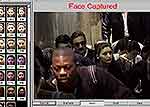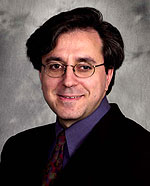By Andrew Haeg
Minnesota Public Radio
October 14, 2002
The Identix Corp., based in Minnetonka, has become a leader in the growing and controversial field of biometrics technology. Biometrics technology identifies people through their physical characteristics. After Sept. 11, the company's fingerprint and facial recognition technology has gained prominence, but so have questions over whether its technology works.
| |
|
|
|
||
The International Association of Chiefs of Police recently held its annual convention in Minneapolis. Identix was one of many companies showing off new crime-fighting technology.
Its products include mobile fingerprinting scanners and facial recognition technology.
The facial recognition system scans a face, measuring the location and distance between up to 80 reference points, like eyes and cheekbones. The computer then compares its findings to pictures in a database of suspected criminals or terrorists. If there is a match, the computer alerts the user, who can verify it.
Identix specializes in fingerprint and facial recognition technology. But Identix CEO Joseph Atick sees boundless opportunities for biometrics -- and for similar technology that scans and processes patterns in nature.
"The world we live in is filled with patterns. The markings on a book are patterns that communicate information. The markings on our finger establish our identity. And the markings on our face allow us to recognize each other," Atick says.
| |
|
|
|
||
"So I believed if we could give some of this knowledge to computers, that we could actually add intelligence to machines. And we're at the tip of the iceberg as far as I'm concerned."
Atick thinks in the future, people will conduct transactions on computers and mobile devices, using biometric identifiers as signatures.
For now though, security rules the day. Government agencies buying security technology are Identix's most important customers. The technology generated enthusiasm after the Sept. 11 terrorist attacks.
John Woodward is a senior policy analyst at Rand, a private, non-profit think tank based in Washington, D.C. He says biometrics proponents may have oversold the technology.
"Biometrics got a lot of hype. It got a lot of publicity. It got a lot of play. And there were a lot of folks who thought biometrics is going to be this technical savior," says Woodward. "It's not going to be our savior. ... It's nothing but a tool. It's one of many tools that we can deploy."
|
"There were a lot of folks who thought biometrics is going to be this technical savior. It's not going to be our savior. It's just a tool. It's nothing but a tool. " - John Woodward, senior policy analyst, Rand
|
A number of airports, including Boston's Logan, tested the technology, with lackluster results. The technology failed half of all potential matches.
Identix officials contend airports used settings that made the technology ineffective. At a medium setting, the company says its facial recognition technology can spot 94 out of 100 suspected criminals or terrorists whose pictures are in the database. But it also comes up with false matches 1 to 3 percent of the time.
People can trick the technology, too. The Learning Channel recently broadcast in the U.S. a BBC documentary about the human face. British comedic actor John Cleese tripped up the facial recognition technology by wearing a pair of sunglasses.
Identix officials concede that the cameras need to see the eyes to match a face.
Civil libertarians like Barry Steinhardt, director of ACLU's technology and liberty program, say the technology's flaws make it dangerous.
"The problem with face recognition is it doesn't work very well. It really fails to identify the bad guys, and winds up accusing a lot of innocent people of being one of the bad guys," says Steinhardt.
| |
|
|
|
||
Identix officials contend the false matches are few, and they're an acceptable trade-off for identifying potential terrorists.
Still, critics say facial recognition technology will enable the government to monitor average, innocent people. Identix's CEO Joseph Atick disagrees. He says the technology has limits on how many people it can identify.
"A camera at a distance, a person in motion in a crowd, you can extract enough information to see if this person belongs to that group of 10,000 people. Once you go to millions, you can't do it," Atick says.
Identix's sales actually declined between 2001 and this year. The company blames a temporary dropoff in defense contracts, and a crowded biometrics marketplace.
Analysts and company officials expect defense spending to rebound, with this year's sales growing by about 15 percent.
Identix merged with Visionics, another biometric technology firm, in July 2002.
More from MPRMore Information



